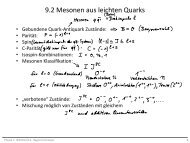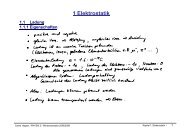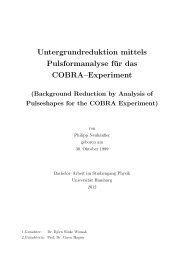Setup of a Drift Tube Muon Tracker and Calibration of Muon ...
Setup of a Drift Tube Muon Tracker and Calibration of Muon ...
Setup of a Drift Tube Muon Tracker and Calibration of Muon ...
You also want an ePaper? Increase the reach of your titles
YUMPU automatically turns print PDFs into web optimized ePapers that Google loves.
Name Reaction Flux [cm −2 s −1 ] E ν,max [MeV ]pp p + p → d + e + + ν e 5.97 × 10 10 0.422pep p + e − + p → d + ν e 1.41 × 10 8 1.442 †hep 3 He + p → 4 He + e + + ν e 7.90 × 10 3 18.87 Be 7 Be + e − → 7 Li + ν e 5.07 × 10 9 0.861 † /0.384 †8 B 8 B → 8 Be + e + + ν e 5.94 × 10 6 16.3413 N 13 N → 13 C + e + + ν e 2.88 × 10 8 1.19915 O 15 O → 15 N + e + + ν e 2.15 × 10 8 1.732Table 2.2: Solar neutrino fluxes on Earth <strong>and</strong> energies. The fluxes are predictedby the BPS08(GS) SSM [41]. Neutrinos marked † are mono energetic, for all otherneutrinos the maximum energy is given.Solar neutrino experiments set an upper limit <strong>of</strong> 2.9% to the fraction <strong>of</strong> energy thatthe Sun produces via the CNO fusion cycle [41]. In principle, reactions includingalso heavier elements are possible. They highly depend on the temperature <strong>and</strong> theabundances <strong>of</strong> elements in the star <strong>and</strong> do not yet contribute to the energy productionin our Sun. To be able to predict the neutrino fluxes from the different processesa variety <strong>of</strong> input parameters is needed for the solar models. One key parameteris the Sun’s metallicity Z, being the fraction <strong>of</strong> heavy elements (> He) in the star.The most elaborate calculations have been developed by the late John N Bahcall [42]<strong>and</strong> are continued by Peña-Garay <strong>and</strong> Serenelli [41]. There are significant differencesbetween models assuming a high metallicity (GS) or low heavy metal abundances(AGS). High metallicity models are more consistent with helioseismological data <strong>and</strong>the predicted neutrino fluxes from this model are presented in Tab. 2.2.For the pp chain <strong>and</strong> the CNO I cycle, the net process for fusion is always4p → 4 He + 2e + + 2ν e + 26.73MeV.About 2% <strong>of</strong> the released energy is carried <strong>of</strong>f by the neutrinos. Flux <strong>and</strong> energy forneutrinos originating from the different processes are shown in Figure 2.1. Neutrinosoriginating from the pep process as well as the fusion <strong>of</strong> 7 Be <strong>and</strong> a proton are monoenergetic because the end state only contains two particles thus resembling a twobody decay. Neutrinos from the pp reaction have the highest abundance, but arewith an energy < 422keV hard to detect.2.3.2 Solar Physics – Solar Neutrinos as MessengersUnlike other particles, neutrinos are the only fusion products in the center <strong>of</strong> the Sunthat have the ability to penetrate to the surface <strong>and</strong> escape into space immediately.Studying the properties <strong>of</strong> solar neutrinos thus makes it possible to study the processesin the core <strong>of</strong> our Sun. Measuring the individual fluxes <strong>of</strong> solar neutrinos fromthe different fusion process allows to constrain the abundances <strong>of</strong> different elementsas well as temperature <strong>and</strong> pressure conditions inside the Sun.Comparing the measured solar neutrino flux to the observed photon luminosity<strong>of</strong> the Sun allows to test the fundamental idea that the Sun shines by nuclear fusion.It takes a few thous<strong>and</strong>s <strong>of</strong> years for visible light produced in the Sun’s core toreach the Sun’s surface, whereas neutrinos are emitted immediately. Neutrino flux12





